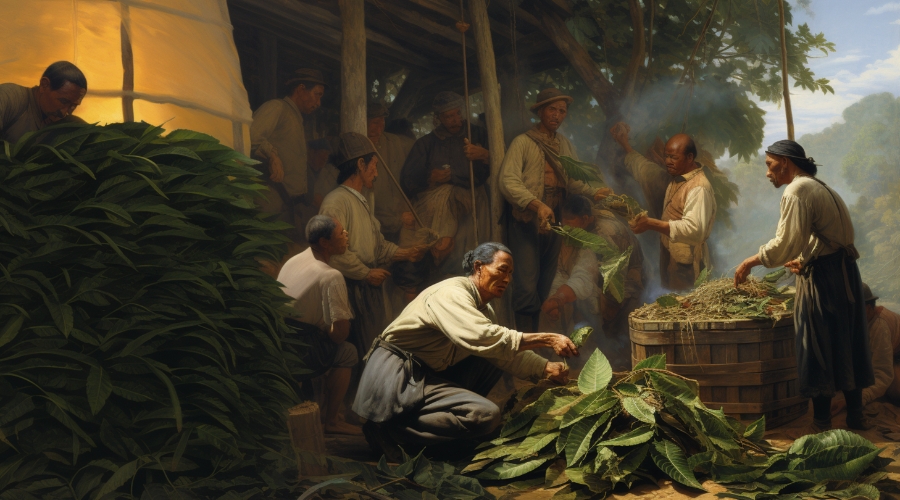Take a journey into the intricate history of kratom, a botanical rooted in Southeast Asia. From traditional practices to its rise in popularity in the West, kratom's narrative is a picture of tradition, regulation, and global evolution. Ready to find out how kratom has shaped societies around the world? Immerse yourself in the fascinating story of kratom's past and discover the secrets that make it the object of intrigue. Curiosity piqued? Read about a fascinating survey backed by expert studies.

Was kratom used for centuries?
Yes, kratom has been used for centuries in Southeast Asia, mainly Indonesia. Kratom, a botanical substance derived from the leaves of the Mitragyna speciosa tree, has a rich history spanning centuries in Southeast Asia, where its preparations have played a multifaceted role in diverse cultural and medicinal practices.
Anthropologists report that kratom has been used in the region for hundreds of years as a multi-purpose remedy in traditional medicine, to increase alertness and energy while working and during social gatherings.
In addition to its more contemporary uses, kratom has a longstanding tradition of being incorporated into socioreligious ceremonies, serving as an integral component in rituals that have been passed down through generations.
The cultural significance of kratom extends beyond ceremonial contexts, as it has been employed for centuries to address a spectrum of medical conditions. Notably, in Thailand, kratom preparations have been historically utilized as a remedy for morphine dependence, showcasing its potential in managing opioid-related issues. The unique alkaloids present in kratom leaves are believed to interact with opioid receptors in a way that helps alleviate withdrawal symptoms, making it a traditional and natural approach to combating substance dependence.
Moreover, in Malaysia, kratom has been recognized as a viable substitute for opium. This historical application underscores the versatility of kratom and its ability to adapt to various cultural and medicinal needs. The use of kratom as an opium alternative in Malaysia is a testament to its potential analgesic properties, which have been harnessed to address pain-related conditions without the associated risks and side effects linked to more potent opioids.
One of the most significant traditions surrounding kratom is deeply rooted in Indonesia, particularly in the lush island of Borneo. This Southeast Asian country has emerged as a primary source of kratom, contributing significantly to the global market, including Europe.
The tradition of cultivating and harvesting kratom in Indonesia holds historical and cultural significance. The rich biodiversity and favorable climate in islands like Borneo have allowed the kratom plant to thrive, resulting in high-quality strains that are highly sought after worldwide.
Kratom from Indonesia, especially Borneo, is often regarded as some of the best in the world. The leaves of the Mitragyna speciosa plant, from which kratom is derived, possess distinct alkaloid profiles that can vary based on factors such as geographical location and growing conditions. The careful cultivation and harvesting practices employed in Indonesia contribute to the exceptional quality of the kratom that is eventually exported to various parts of the globe, including Europe.
As we explore the intricate tapestry of kratom's historical and cultural connections, it becomes evident that this botanical substance has been an integral part of societies, offering not only relief from medical ailments but also contributing to the rich fabric of ceremonial practices.
The continuing exploration of kratom's properties and applications sheds light on its potential benefits and fosters a deeper understanding of its role in human history.

When was kratom discovered?
The exact history of kratom's discovery is uncertain. The earliest recorded reference to kratom dates back to 1836, when it was described in the journal "Transactions of the Linnean Society of London" as a substitute for opium among the Malays.
According to National Library of Medicine, the scientific community began to investigate kratom more closely in the early 20th century. In 1921, British chemist Ellen Field isolated the main active alkaloid in kratom, mitragynine. Since then, scientists have identified over 40 other alkaloids in kratom, most of which are similar to mitragynine in structure and function.
While kratom has been used for centuries in Southeast Asia, especially in Indonesia, more specifically in Borneo, its popularity has been growing in the Western world in recent years.
This is due in part to the increasing availability of kratom online and in head shops. Kratom is often marketed as a natural alternative to prescription pain medications and as a way to boost energy and mood.
Overall, the history of kratom is a complex one, with a long tradition of use in Southeast Asia juxtaposed with recent concerns about its safety and legality in the Western world. More research is needed to fully understand the effects of kratom and to develop guidelines for its safe and responsible use.
History of kratom in Europe
The history of kratom in Europe is relatively recent, with its introduction largely dating back to the early 21st century. The plant, native to Asia, gained popularity in Europe as an alternative to traditional pharmaceuticals for managing pain, anxiety, and other ailments. Here is a closer look at some countries relation with kratom:
Germany: Germany was among the first European countries to witness kratom's growing popularity. In 2012, the German government classified kratom as a "novel psychoactive substance," requiring online sellers to register with the authorities. However, kratom remained widely available in physical stores and online marketplaces. In 2020, the German government launched a comprehensive review of kratom's status, considering its potential benefits and risks. The review concluded that kratom should remain legal, but with stricter regulations on its sale and marketing. These regulations include age restrictions, labeling requirements, and bans on irresponsible advertising.
France: France took a different approach to kratom, banning its possession and purchase in 2020. The ban was driven by concerns about kratom's potential for addiction and misuse. However, there have been calls to reconsider the ban, highlighting the lack of scientific evidence supporting the claims of harm.
Spain: Spain has not taken a firm stance on kratom, leaving it technically legal for personal use. However, the sale and distribution of kratom are prohibited without a license. This regulatory limbo has led to concerns about the quality and consistency of kratom products available in Spain.
Czech Republic: Of the European countries, kratom has probably gained the most popularity in the Czech Republic. Czechia has not taken any specific action on kratom, leaving its legal status unclear. However, the Czech Health Institute has issued warnings about kratom's potential for addiction and harm. This ambiguity has created uncertainty among kratom users and retailers in the country.
Austria: Kratom is technically legal in Austria, but it is subject to certain restrictions. The sale of kratom is prohibited to minors, and retailers must prominently display warning labels about potential risks.
Belgium: Kratom is also legal in Belgium, but it is subject to age restrictions and labeling requirements. The Belgian government has expressed concerns about kratom's potential for addiction and misuse, and it is monitoring the situation closely.
Italy: Italy has not taken a definitive stance on kratom, leaving its legal status unclear. The Italian Ministry of Health has issued warnings about potential risks associated with kratom, but it has not implemented any specific regulations.
Netherlands: Kratom is legal in the Netherlands, but it is subject to age restrictions and labeling requirements. The Dutch government is committed to evidence-based policymaking and is closely monitoring the situation regarding kratom.
Overall, the history of kratom in Europe is marked by a complex interplay of legality, regulation, and public perception. While some countries have outright banned kratom, others have adopted a more cautious approach, emphasizing education and harm reduction strategies. The debate over kratom's future in Europe is likely to continue as more research is conducted and public awareness grows.
Historical roots in Southeast Asia
Kratom, scientifically known as Mitragyna speciosa, has roots in Southeast Asia, specifically Indonesia, Malaysia, Thailand, and Myanmar. Indigenous communities chewed fresh leaves or brewed tea for pain relief and increased energy. Despite its traditional use and recent popularity, kratom's global recognition is limited, and ongoing research is essential for a comprehensive understanding of its benefits and risks.
From tradition to recreation: Kratom's global evolution
Kratom, the botanical name Mitragyna speciosa, has undergone a significant transformation in its global presence and usage patterns. Kratom has gained widespread recognition and recreational use in recent years, particularly in Western countries.
This shift has brought forth both positive and negative implications, highlighting the complex nature of kratom's evolution and its impact on societies worldwide.
Recreational use and global Expansion
Over the past two decades, kratom's popularity has extended beyond its traditional Southeast Asian usage, gaining traction in Western countries. This expansion is attributed to the Internet and its ability to connect people, facilitating the spread of information about kratom and its potential benefits. Online forums and media (including social media importantly) platforms have played a significant role in promoting kratom's recreational use, often highlighting its ability to alleviate pain, reduce anxiety, and enhance mood.
Concerns
The growing popularity of kratom has raised concerns among health authorities and regulatory bodies worldwide. The little lack of comprehensive scientific research on kratom's long-term effects has fueled apprehensions about potential health risks. In response to these concerns, various countries have implemented regulatory measures, ranging from restrictions on sales to outright bans.
Traditional use, recreation, and safety
The evolution of kratom from a traditional medicinal plant to a recreational substance highlights the need for a balanced approach that considers its potential benefits alongside the risks associated with its usage patterns. While acknowledging the long history of kratom's traditional use in Southeast Asia, it is crucial to address the concerns raised by its recreational consumption in Western countries.
Conclusion
Kratom's global evolution underscores the complex interplay between traditional medicinal practices, recreational substance use, and regulatory responses. Understanding the historical context and cultural significance of kratom is essential for developing informed and evidence-based policies that address the multifaceted aspects of its use and potential impact on public health.
Slight controversies
Kratom, an herbal supplement derived from the leaves of the Mitragyna speciosa tree in Southeast Asia, is surrounded by little controversies due to insufficient research on its safety and efficacy. Concerns include its potential for addiction and abuse. Mixed perspectives highlight potential benefits for pain and opioid withdrawal, while opponents call for greater regulation or a ban.
Other debates involve its effectiveness for specific conditions, interactions with medications, and product quality control. Informed discussions are essential as the use of kratom continues to expand.
So what is the history of kratom in a nutshell?
Kratom, derived from the Mitragyna speciosa tree, has a centuries-old history in Southeast Asia, serving various purposes in traditional medicine, social gatherings, and religious ceremonies. Its use in Thailand for morphine dependence and in Malaysia as an opium substitute highlights its versatility. The earliest recorded mention dates back to 1836, with mitragynine, its main alkaloid, identified in 1921. In recent years, kratom has gained popularity in the Western world as a natural alternative for pain management and mood enhancement. Europe's history with kratom is relatively recent, marked by varying regulations across countries, from stricter guidelines in Germany to a ban in France. The global evolution of kratom includes its transition from a traditional medicinal plant to a recreational substance, sparking concerns about safety and regulatory responses.
Our tip: Read also about the Kratomit founder's journey to Borneo.
_(1).svg)